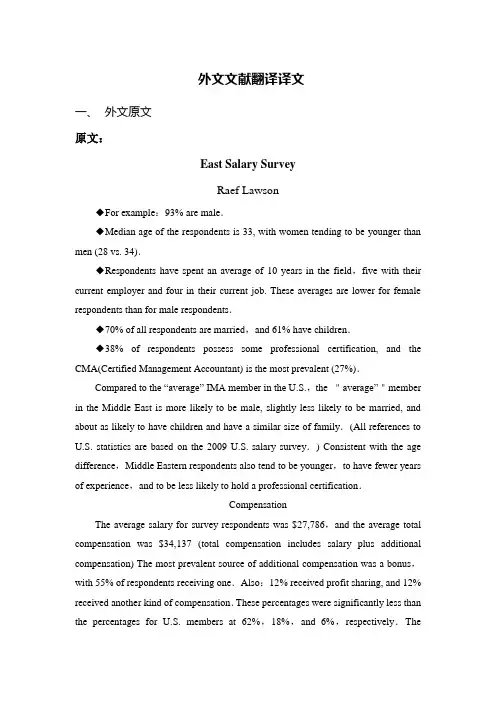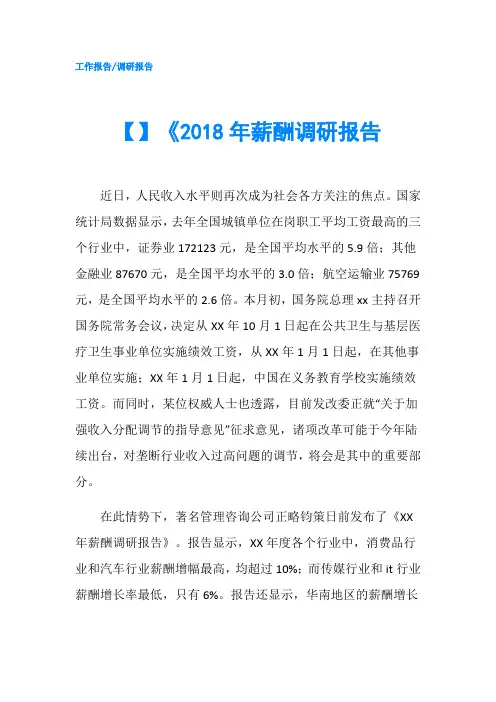2018年中国薪资调查报告(英译中)
- 格式:pptx
- 大小:9.49 MB
- 文档页数:29


外文文献翻译译文一、外文原文原文:East Salary SurveyRaef Lawson◆For example:93% are male.◆Median age of the respondents is 33, with women tending to be younger than men (28 vs. 34).◆Respondents have spent an average of 10 years in the field,five with their current employer and four in their current job. These averages are lower for female respondents than for male respondents.◆70% of all respondents are married,and 61% have children.◆38% of respondents possess some professional certification, and the CMA(Certified Management Accountant) is the most prevalent (27%).Compared to the “average” IMA member in the U.S.,the "average”"member in the Middle East is more likely to be male, slightly less likely to be married, and about as likely to have children and have a similar size of family.(All references to U.S. statistics are based on the 2009 U.S.salary survey.) Consistent with the age difference,Middle Eastern respondents also tend to be younger,to have fewer years of experience,and to be less likely to hold a professional certification.CompensationThe average salary for survey respondents was $27,786,and the average total compensation was $34,137 (total compensation includes salary plus additional compensation) The most prevalent source of additional compensation was a bonus,with 55% of respondents receiving one.Also:12% received profit sharing, and 12% received another kind of compensation.These percentages were significantly less than the percentages for U.S. members at 62%,18%,and 6%,respectively.Theopportunities for women to receive such additional compensation were less than for men,with only 42% and 2%,respectively,of the women receiving bonuses and profit sharing.Respondents’ compensation varied greatly among the countries surveyed.IMA members in Qatar received the highest average base salary and total compensation,and those in Egypt received the lowest compensation.shows a comparison of salaries and total compensation by country(all compensation figures are presented in U.S. dollars).As you might expect,salaries within a given category are fairly uneven,with higher salaries often distorting the picture of what the"average"member earns.To address this issue,I present both mean and median income information in Table 3 and throughout the article.The percentage of total compensation from the base salary is lower for Middle Eastern respondents (81%) than for U.S. respondents (86%),reflecting the greater use of other sources of compensation (such as travel and housing allowances) in the Middle East.Male/Female CompensationIMA’s U.S. salary survey has consistently focused on the disparity between the compensation of men and women,and the 2009 survey found that women’s salaries averaged 77% of the men’s salaries and that the percentage was74% for total compensation.As indicated in,these percentages were even lower (58% and 52%, respectively) in the Middle East.The comparison of median compensation levels indicates an even greater disparity.These differences can be attributed in part to demographics.The women in this survey tended to be younger than the men(median ages of 28 and 34, respectively),less likely to hold an advanced degree (18%vs23%),less likely to be professionally certified (26% vs 35%),to be earlier in their careers than the men (a median of seven vs10 years of experience in the field),and more likely to hold entry-level positions.All of these differences are statistically significant.Additional insight into the difference in compensation of men and women isprovided,which presents compensation by gender and years in the field.As expected,salary and total compensation increased for both men women as they accumulated greater experience.The only exception to this trend was for men in the field more than 20 years.The same exception was observed in the U.S. survey.In the latest U.S. survey,women’s salary as a percentage of men’s ranged from 70% to 84% in the various"years in the field"categories.Total compensation ranged from 60% to 85%.As indicated in the last two columns,the spread of these percentages is much greater in the Middle East.A surprising result is the tremendously larger amount that women in the field 11 to 15 years received than men with similar experience.This may reflect the region’s great shortage of women with that amount of experience,as shown by few female respondents in that experience category and the consequent need to pay higher compensation.More respondents are at the middle-management level,followed by senior,entry-level,and top management. Few members in academia responded to the survey,perhaps reflecting the current lack of an academic membership category internationally.Reflecting the scarcity of women with more than 10 years of experience,there’s a much smaller percentage of women than men employed in top management positions.Given the typically higher salaries paid at this level,the impact of this disparity is clear.This picture is quite different from the situation in the U.S. survey,where the percentage of women in this category was approximately twice that of men.Other major differences exist at the entry level,with many more women at this level in the Middle East than in the U.S.,and in academia,with women much more prevalent in the Middle East than in the U.S. This last difference is encouraging because,as noted in the U.S. salary survey,female professors can serve as positive role models for young women considering a career in accounting.The relative scarcity of women in top-level management in the Middle East is only part of the"compensation"problem.Another issue, which also exists in the U.S.,is that women earn less than men at each level of management.The problem is greatest at the top-management level,where women receive less than half thecompensation of their male counterparts.Tremendous differences also exist at the lower/entry and senior-management levels.The disparity is least for middle managers.Consistent with the trend in the U.S.,as men advance in rank,their compensation increases.This clearly makes sense-greater compensation should accompany greater responsibility and authority.A different trend is evident for women.While receiving greater compensation as they transition from lower levels of management to middle management,their compensation fails to increase commensurately as they achieve higher management ranks.(The data actually reflects decreasing compensation.) The failure of women’s pay to advance with their role in the organization may help explain their absence in senior and top management.One factor that helps explain the disparity in pay between the genders at the various levels of management is professional certification.At the entry level of management,only 8% of women are certified vs.17% of men.This difference disappears at the middle-management level (39% of women vs. 40% of men) but then reappears at the senior-management level (29% of women vs. 47% of men).These differences closely reflect the difference in compensation at the various management levels and clearly point to the importance of professional certification in career advancement and increases in compensation.Men are much more likely to hold positions with major supervisory responsibilities,and women are likely to have some supervisory responsibilities but not be head of a major department.Not unexpectedly,the greatest compensation goes to those members who are head of a major department and report directly to a CEO or Board of Directors.This category is followed by those who are head of a major depart ment but don’t report directly to the CEO or Board,those who have some supervisory responsibility but aren’t head of a major department,those who have little or no supervisory responsibility and report directly to a CEO or Board,and,finally,those with no supervisory responsibility.Not surprisingly,those with greater supervisoryresponsibility receive greater compensation.Although this ranking in terms of compensation holds when examining the men’s compensation,the situation isn’t as clear for women.Based on median compensation,roughly the same ranking exists,but based on mean compensation,the women who are most highly compensated are those who have some supervisory responsibility but aren’t the head of a major department.These women have titles such as auditor,senior accountant, and divisional controller.A similar relationship between compensation and supervisory responsibilities occurred in the U.S. survey,with the exception that those with little or no supervisory responsibility and who report directly to a CEO or Board of Directors were paid more on average than those who have some superviso ry responsibility but aren’t head of a major department.In the U.S. survey,the most highly paid women were those who were head of a major department but didn’t report directly to the CEO or Board.Thus there’s a greater similarity regarding the effect of supervisory responsibilities on pay for Middle East and U.S. men than for women.To summarize the effect of gender on compensation:◆Women respondents in the Middle East tend to be younger than women respondents in the U.S.,and women receive less compensation than men do within each age category.◆Women tend to have fewer years of experience in the field,and,on average,those with less than 10 years of experience are paid significantly less than men,while those who have been in the field 11 to 15 years are paid much more than men.◆Women are less likely to have top- or senior-management positions,and,on average,women in those positions are paid less than men.The same holds true for major supervisory responsibilities.Compensation and CertificationAs noted previously,38% of the survey respondents are certified,including 27% who are CMAs and 5% who are Certified Financial Managers(CFMs).How important is certification with regard to compensation?On average,certified members in the Middle East earned $42,132 in salary and $51,186 in total compensation as comparedto $18,950 and $23,580 for noncertified members.Thus,on average,certified members earn 122% more in salary and 117% more in total compensation than noncertified members.The certification premium is greatest for the 30-39 age range,but,for every age range,those who are certified earn significantly more than those who aren’t,indicating the value of certification through-out a career.Compensation and DegreesWe saw that nearly all survey respondents had at least a baccalaureate degree and that 22% had an advanced degree.Shows the salary and total compensation by degree.Surprisingly,those without a college degree earned more,on average,than those with a baccalaureate degree.Respondents with a master’s degree had the highest compensation of any group,and those with a doctorate earned less.The relationship between the income of those with less than a baccalaureate and those with a baccalaureate degree may be because,of all four educational groups,respondents with a baccalaureate degree had the fewest number of years of experience in the field.Given this result,given that the professional certifications discussed in the prior section require a college degree,and given the results in the previous section regarding the effect of certification on income,a reasonable strategy for those with a baccalaureate degree who want to increase their income may be to pursue certification.How do the U.S. and the Middle East compare regarding the effect of education on compensation?In the Middle East there’s a much greater"master’s premium"than in the U.S. with regard to salary and total compensation.Also,in both regions,those with doctorates earned more than those with baccalaureate degrees but less than those with master’s degrees.Yet the"doctorate premium"is larger in the Middle East than in the U.S..Compensation by Organizational Structure and Industry Let’s also examine average salary and total compensation based on the number of employees in the respondent’s location and the total number of employees in therespondent’s organization.That it’s difficult to make generalizations regarding the effect of organization size on compensation.When looking at income by size of location,those in units with 500 to 999 employees earned the most (with regard to both salary and total compensation),and organization-wide those employed in companies with 5,000 or more employees were more highly compensated.This result is somewhat similar to the U.S. survey,which found that those in locations with 5,000 or more employees and those in companies of a similar size earned the greatest incomes.But as the authors of the U.S. survey note,there hasn’t been a defined pattern between income and location and organization size over the years.Members’ income also varied considerably by industry.Given the importance of oil to the Middle East economy,it isn’t surprising that the highest salaries and total compensation are paid in the mining/natural resource extraction industry.Next most highly compensated are those working in government.The largest number of members work in finance,insurance,and real estate,and their average salary and total compensation ranked fifth and fourth,respectively,among the 13 industry categories.The fewest number of respondents, and those who earned the least,on average,were those in agriculture, forestry, and fisheries.Although the most common form of employer organization was a publicly traded corporation,nearly as many members work in partnerships,and significant numbers also work in family-owned companies and privately held companies.These results contrast with the U.S. results in several ways.Members in the U.S. were more likely to work for large companies than were Middle Eastern members.For example,41% of U.S. respondents worked for publicly held companies,but only 26% of Middle Eastern members did so.For privately held companies,the percentages were 32% and 18%, respectively.In terms of compensation,those working for publicly traded corporations receive,on average,the highest salaries and total compensation.A similar result was observed in the U.S. survey.Next most highly compensated were those employed byprivately held corporations.Those in academia earned the least.Compensation by Responsibility and PositionThe grouping of positions by management level has been modified slightly from that used in the U.S. survey to better reflect the respondents’level as self-reported.Also,some positions may be at different management levels in different companies.As expected, salary and total compensation generally increase at higher levels of management.A relatively large number of respondents are CFOs,and,on average,they ranked quite highly with regard to compensation.It’s interesting that while the relatively high compensation of top management in the U.S. has been the subject of criticism,the disparity between the compensation of top-level managers and those at the lower level is greater in the Middle East.In this survey,the mean total compensation of top managers in the Middle East was 539% that of lower-level managers,in the U.S. survey this percentage was 246%.The effect of responsibility area on compensation is presented in.The areas are ranked in descending order based on average total compensation.Interestingly,information systems,which ranks only seventh (out of 14) in the U.S. survey,is the most highly compensated area in this survey.Internal audit and risk management also rank relatively high.Public accounting and taxation,ranked relatively highly in the U.S.,rank much lower in the Middle East.Alternate Career PathsCompensation is only one part of the decision to pursue a given job and career.For many people,flexibility in working hours and career path is also important.Forty-four percent of both men and women surveyed would choose to reduce their working hours and take a corresponding decrease in compensation.This is greater than for the men (29%) and women (42%) in the U.S. survey.Middle Eastern women on average are interested in a greater reduction than are men.The percentage of men for whom this is relevant(74%)is slightly more than for women (70%),but of the group for which this was a relevant consideration,more women(50%) than men(33%) would pursue the career flexibility option.These figures contrast with those from the latest U.S. survey in an interestingway.Fewer U.S. respondents had this as a relevant concern (62% of women and 59% of men),yet, of that group,more women (86%) than men (71%) would prefer that option.A final factor impacting compensation is career interruptions.Eight percent of the respondents have had a career interruption of at least six months,with women (15%) more likely than men (7%) to have had such an interruption.This is one-third the comparable rate (24%) from the U.S. survey for both men and women.A substantial difference exists between the U.S. and Middle East surveys with regard to the impact of career interruptions on compensation.The U.S. survey found a significant negative impact on average salary from an interruption-8.5% for women and 11.8% for men.A similar analysis of the Middle East data surprisingly indicates higher average salaries for those who have had such a career interruption,probably because more people with substantial experience take a leave than do newly hired employees.Unfortunately,there isn’t enough data to isolate the effect of this variable on compensation.Average Salary ProfilePresents average salary earned across management level,certification,and level of education.(There weren’t enough responses from women members to also analyze the data by gender.) When looking at the table, keep in mind that many other factors (such as industry,experience,and organizational size) also affect compensation,so adjustment for them may need to be made when applying these numbers to specific cases.As expected,indicates that salaries generally increase as a person moves up in management,that certified members earn more than noncertified members,and that those with a master’s degree earn more than those with just a baccalaureate.An exception to these rules is that,on average,entry-level managers with a master’s degree earn more that middle managers.This may reflect a rise in starting salaries for accounting professionals as demand for qualified people increases.Pursuing AdvancementThis is an interesting time to start surveying the compensation of IMA membersin the Middle East.From an economic perspective,the past several years have certainly been challenging to many.The observed disparity between the compensation of men and women members adds to the challenge women members face.Yet a bright spot for all is the fact that only 2.4% of survey respondents indicated they were unemployed,which was close to the 2.0% in the latest U.S. survey.The results of this survey indicate the value of higher education, professional certification,and professional experience in advancing your career and earning higher pay.These results should encourage members in the Middle East to pursue these avenues for advancement as they progress in their careers and expand the field of management accounting in the region.(节选)Raef Lawson.East Salary Survey.Strategic Finance,2010(10)P29-49.二、翻译文章译文:东方薪酬调查(IMA 管理会计师协会)瑞夫劳森(一)调查的样本:◆93%是男性◆年龄中间值为33岁,女性比男性年轻(中间值28 对 34)◆受访者在这一行业工作时间平均为10年,为当前雇主工作5年时间,在当前岗位上4年时间。





工作报告/调研报告【】《2018年薪酬调研报告近日,人民收入水平则再次成为社会各方关注的焦点。
国家统计局数据显示,去年全国城镇单位在岗职工平均工资最高的三个行业中,证券业172123元,是全国平均水平的5.9倍;其他金融业87670元,是全国平均水平的3.0倍;航空运输业75769元,是全国平均水平的2.6倍。
本月初,国务院总理xx主持召开国务院常务会议,决定从XX年10月1日起在公共卫生与基层医疗卫生事业单位实施绩效工资,从XX年1月1日起,在其他事业单位实施;XX年1月1日起,中国在义务教育学校实施绩效工资。
而同时,某位权威人士也透露,目前发改委正就“关于加强收入分配调节的指导意见”征求意见,诸项改革可能于今年陆续出台,对垄断行业收入过高问题的调节,将会是其中的重要部分。
在此情势下,著名管理咨询公司正略钧策日前发布了《XX 年薪酬调研报告》。
报告显示,XX年度各个行业中,消费品行业和汽车行业薪酬增幅最高,均超过10%;而传媒行业和it行业薪酬增长率最低,只有6%。
报告还显示,华南地区的薪酬增长率最低,华北其他城市平均薪酬增长率最高,呈现出北高南低的增长趋势。
陷危机it行业遭遇滑铁卢今年二季度以来,gdp增速加快,XX年上半年新增贷款规模增速超过200%,半年新增贷款规模超过去年全年,人民币汇率走势以“稳”为主,全国70个大中城市房地产销售价格在3月触底后,同比及环比同时呈现加速上涨局面。
从当前经济形势分析,预计可实现政府制定的“保8”目标。
“正略钧策通过近十年的研究发现,工资增长速度相对于gdp 增长速度有一定的滞后现象。
”据上海正略钧策副总监刘羿葳介绍,XX年经济危机对企业的影响程度从高到低排列依次为中外合资企业、外商独资企业、民营企业、国有企业,其中,国有企业受到的积极影响大于消极影响。
“所有行业中,it行业所受到经济危机的消极影响最为明显,经济危机削减了电子消费品的需方,而产品成本不降反升,这更让it行业‘雪上加霜’;而地域差异对企业的制约也较大,由于一线城市的整体宏观经济市场的市场化进程和竞争激烈程度要远高于二、三线城市,因此前者受到外部经济影响深远度和敏感度普遍高于后者,这导致一级城市企业对经济危机的影响普遍持负面态度。




本文部分内容来自网络整理,本司不为其真实性负责,如有异议或侵权请及时联系,本司将立即删除!== 本文为word格式,下载后可方便编辑和修改! ==201X年中国HR薪酬调查报告步入 201X 年,国内面临着产业经济转型,企业面临着前所未有的挑战。
房价、物价的不断增长,企业的用工成本也逐年增加。
到底花多少钱才能招到合适的人,到底应该如何定薪酬,年度调薪该如何做,这是每到调薪季节HR最苦恼的事情。
本次《201X年HR 薪酬调查问卷》的调查,收到了15580 名HR的问卷回应,涵盖了中国 20 多个行业、34 个省市地区,包括部分港澳台及海外 HR 的参与,得到 HR 了有关 HR 薪酬比较精准的信息。
一、全国薪酬状况对比1、各省市 HR 薪酬状况对比调查表明,沿海地区薪资明显高于内地省市,上海领跑全国薪资,沿海地区中北京、广东、浙江、江苏为经济强省,福建、天津、山东、辽宁薪资在沿海地区为第二梯队;西部地区四川、重庆、新疆薪资状况较佳,其他西部省市样本太少未列入统计;中部地区经济发展不平衡,整体落后于沿海地区,山西、河南、江西在中部地区薪资较低。
2、全国 HR 薪酬分布情况调查表明,有 25.42% 的专员薪资在 3001-3500 元范围,有 36.75% 的专员薪资在201X-3000范围,还有11.33%的专员在4001-4500范围,共有超过62.17%的专员薪资在201X-3500范围;有 18.31% 的主管在 3001-3500 范围,有 28.26% 的主管薪资在 3501- 4500,有16.71%的主管在5001-6000范围,共有46.57%的主管在3001-4500 范围;有19.54%的经理在5001-6000范围,有12.51%的经理在7001-8000范围,还有11.77%的经理在4001-4500范围,共有46.85%的经理在5001-9000范围;有13.47%的总监在1201X-15000范围,有12.15%的总监在9001-10000范围,有11.27%的总监在15001-201X0范围,共有39.68%的总监在10001-25000范围。
2018热点行业薪酬报告REMUNERATION REPORTMEDICAL INDUSTRYENERGY AND CHEMICAL INDUSTRYCONSUMER GOODSAUTOMOBILE AND MANUFACTURINGFINANCIAL INDUSTRYINTRODUCTIONREMUNERATIONINTERNET INDUSTRYNICHE BUSINESS RESEARCH INSTITUTE引言行业薪酬概览细分行业互联网行业金融行业IT通信行业房地产行业汽车与制造行业消费品行业能源化工行业医疗行业传媒行业关于埃摩森研究院TABLEOFCONTENTIT COMMUNICATION INDUSTRYREAL ESTATE INDUSTRYMEDIA INDUSTRY010306 071116 21 26313641 46 512018年,我国经济增速逐渐趋缓,供给侧改革进一步深化,我国经济正处于产业结构调整、新旧动能转换的空档期。
在此经济形势下,国内企业面临较大的发展压力,持续增长的薪酬成本也将变得更加难以接受,而炙手可热的人才恰恰需要企业以高竞争优势的薪酬来吸引。
在经历着劳动力成本日渐上升挑战的同时,人才稀缺,特别是高级技工和管理层,将会造成激烈的市场竞争。
为了保持市场竞争力,企业该如何锁定关键人才?又该如何分配涨薪池,制定合理的人才发展计划?为回答这些问题,埃摩森研究院立足于埃摩森人力集团强大的数据库系统,编制了《埃摩森AIMSEN:2018热点行业薪酬报告》,本报告涉及9大热点行业多个核心岗位的薪酬信息,旨在帮助企业了解2018年各行业的薪酬分布及劳动力市场趋势,让人力资源更好地制定薪资分配方案,规划未来的薪酬管理战略,在合理可控的预算下实现人才的保留与激励。
引言INTRODUCTION《埃摩森AIMSEN :2018热点行业薪酬报告》内所有数据皆经过科学收集和分析所得,该报告反映的行业薪酬状态,具有一定的参考性,但不具有直接决策性。